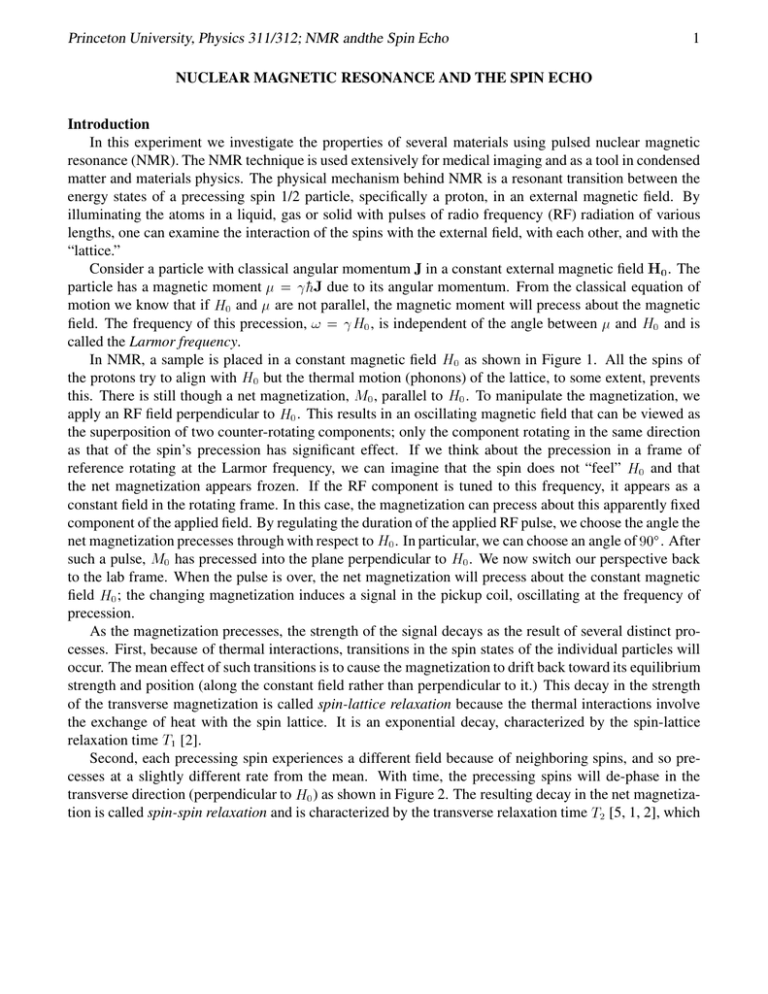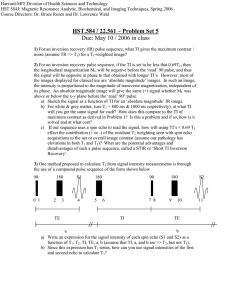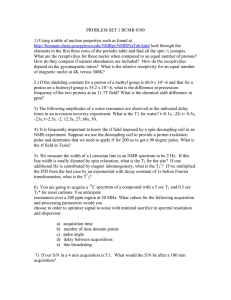nuclear magnetic resonance and the spin echo
advertisement

Princeton University, Physics 311/312; NMR andthe Spin Echo 1 NUCLEAR MAGNETIC RESONANCE AND THE SPIN ECHO Introduction In this experiment we investigate the properties of several materials using pulsed nuclear magnetic resonance (NMR). The NMR technique is used extensively for medical imaging and as a tool in condensed matter and materials physics. The physical mechanism behind NMR is a resonant transition between the energy states of a precessing spin 1/2 particle, specifically a proton, in an external magnetic field. By illuminating the atoms in a liquid, gas or solid with pulses of radio frequency (RF) radiation of various lengths, one can examine the interaction of the spins with the external field, with each other, and with the “lattice.” Consider a particle with classical angular momentum J in a constant external magnetic field 0 . The particle has a magnetic moment = h due to its angular momentum. From the classical equation of motion we know that if H0 and are not parallel, the magnetic moment will precess about the magnetic field. The frequency of this precession, ! = H0 , is independent of the angle between and H0 and is called the Larmor frequency. In NMR, a sample is placed in a constant magnetic field H0 as shown in Figure 1. All the spins of the protons try to align with H0 but the thermal motion (phonons) of the lattice, to some extent, prevents this. There is still though a net magnetization, M0 , parallel to H0 . To manipulate the magnetization, we apply an RF field perpendicular to H0 . This results in an oscillating magnetic field that can be viewed as the superposition of two counter-rotating components; only the component rotating in the same direction as that of the spin’s precession has significant effect. If we think about the precession in a frame of reference rotating at the Larmor frequency, we can imagine that the spin does not “feel” H0 and that the net magnetization appears frozen. If the RF component is tuned to this frequency, it appears as a constant field in the rotating frame. In this case, the magnetization can precess about this apparently fixed component of the applied field. By regulating the duration of the applied RF pulse, we choose the angle the net magnetization precesses through with respect to H0 . In particular, we can choose an angle of 90Æ . After such a pulse, M0 has precessed into the plane perpendicular to H0 . We now switch our perspective back to the lab frame. When the pulse is over, the net magnetization will precess about the constant magnetic field H0 ; the changing magnetization induces a signal in the pickup coil, oscillating at the frequency of precession. As the magnetization precesses, the strength of the signal decays as the result of several distinct processes. First, because of thermal interactions, transitions in the spin states of the individual particles will occur. The mean effect of such transitions is to cause the magnetization to drift back toward its equilibrium strength and position (along the constant field rather than perpendicular to it.) This decay in the strength of the transverse magnetization is called spin-lattice relaxation because the thermal interactions involve the exchange of heat with the spin lattice. It is an exponential decay, characterized by the spin-lattice relaxation time T1 [2]. Second, each precessing spin experiences a different field because of neighboring spins, and so precesses at a slightly different rate from the mean. With time, the precessing spins will de-phase in the transverse direction (perpendicular to H0 ) as shown in Figure 2. The resulting decay in the net magnetization is called spin-spin relaxation and is characterized by the transverse relaxation time T2 [5, 1, 2], which J H Princeton University, Physics 311/312; NMR andthe Spin Echo 2 Magnet Pulse Programmer RF Synthesized Oscillator RF Amp Probe z,H 0 Mixer Scope Sync Signal Receiver RF Amp Detector Figure 1: A schematic diagram of the apparatus. Note that the RF coil that makes the pulses and the coil that senses the precessing spins are orthogonal to each other and to the applied magnetic field. The gain and passband of the RF receiver are controlled by the leftmost module in the TEACHSPIN electronics rack. The pulse programmer is in the center module and the RF amplifier and mixer are in the rightmost module. Note that the high powered RF lines do not use BNC cables. is strictly less than T1 [1,p.36]. Note that the RF coil that makes the pulses and the coil that senses the precessing spins are orthogonal to each other and to the applied magnetic field. The gain and passband of the RF receiver are controlled by the leftmost module in the TEACHSPIN electronics rack. The pulse programmer is in the center module and the RF amplifier and mixer are in the rightmost module. Note that the high powered RF lines do not use BNC cables. To see a “spin echo,” we apply a second pulse of RF field, with twice the duration of the first; this pulse is called a 180Æ pulse. The spins will precess a half-turn with respect to the applied field. Thus phases of the individual spins will be reversed, then the spins revert to precession about the constant field. However, since the phases are reversed, the precession now has the effect of making up the differences in phase, so that after a time equal to the time in which they were created, the phase differences will be compensated for. Thus after a time 2 we can see an echo of the original magnetization which will have a width T2. If we continue to apply 180Æ pulses, at times ; 3; 5 ... we will see echoes at times 2; 4 ,... The echoes will die out exponentially with characteristic time T2, as spin-spin precesses lead to unrecoverable loss of phase. This is called the Carr-Purcell method, and takes care of the problem described in the next paragraph. If, instead of applying a sequence of 180Æ pulses, we use a composite of the results from applying one such pulse at different times, for some materials the result will be quite different. Because there is an increasing amount of time between the 90Æ and 180Æ pulses, the molecules have more time to move about, into areas of different magnetic field. This is the effect of diffusion; it causes the magnitude of the echoes to drop off at a rate much faster than standard exponential decay [8, pp.634-636],[2, pp.59-62]. A similar technique to that of spin echoes can also be used to find the characteristic time T1 of the spin-lattice decay [2, pp.63-64]. In this method, we begin with a 180Æ pulse, followed by a single 90Æ pulse at time . The first pulse will cause the initial magnetization to precess until it is antiparallel to H0 , Princeton University, Physics 311/312; NMR andthe Spin Echo z z 3 z y z y y y x x x A x E C G z z H y y 1 x x B z z x x D y y F H Figure 2: The formation of a spin echo using the Carr-Purcell pulse sequence in the rotating frame. In A, spins are aligned and produce a net magnetization in the plus z direction, parallel to the external field. In B, using a 90Æ pulse, the spins are precessed down to the y-axis (C). In D, they start to de-phase due to variations in the external field. In E, a 180Æ pulse is applied to flip the spins around the x-axis so that they re-phase as in F and produce an echo in G. In H, the spins begin to de-phase again. Taken from Carr and Purcell (Phys. Rev. Vol 94, pg 630, 1954). you should not see any inductance after the pulse; magnetization will then begin to decay back toward its equilibrium value. The application of the 90Æ pulse brings the residual magnetization into the transverse plane. Tune the delay to the so-called “zero-crossing point.” This occurs when you don’t see any inductance after the second pulse. The decay constant T1 is now equal to the delay divided by ln 2. Outline of Experimental Apparatus We used a device from the TEACHSPIN company. Norm Jarosik, a member of our physics department and co-owner of the company, designed and built the apparatus you will use. A complete description of the apparatus is given in the Big Red Manual in the lab room and you should consult it when you have questions. The following a summary. The electronics that control the RF signals are housed in three modules. The lefthand module contains the amplifier for the signal coming from the pick-up coils. It has a gain adjust with 60 dB (106 ) range and so is easily saturated. There is a cross-talk between the pickup and transmitter coils, even though they are at right angle to each other. In order to relieve the amplifier from overloads, blanking signal is used to shut down the amplifier during the pulses. The module is also capable of detecting the envelope of the signal. Also it is possible to broadly tune the frequency of the signal that you want to amplify with a selectivity of 200 kHz. The central module is the pulse generator. It can produce two types of pulses called A and B. One can continuously adjust the width of the pulses in 1 30 s range. The delay time and the number of B pulses in the pulse train is adjusted by dialing the digits. The mode switch should be in INT position. The right-hand module is the RF generator. The frequency is quartz locked and is displayed digitally on the LED display. The output is triggered by pulses from the pulse generator. The mixer is also housed in Princeton University, Physics 311/312; NMR andthe Spin Echo 4 this unit. It multiplies the two input signals and outputs the envelope of the product, which has a frequency equal to the difference in frequencies of the inputs. Thus can be used to finely match the frequencies of the two input signals by eliminating the beat on the output. One input comes from the amplifier and the other is the internally generated RF signal. Use the output of the mixer for monitoring the signal on the oscilloscope. The magnet is very high quality permanent magnet with a field of 3-4 kG. Its shape is optimized for maximum homogeneity. Please DO NOT bring metallic objects, like screwdrivers, near it! Experiments It is recommended that you first read Getting Started in the Big Red Manual. You should investigate the properties of beeswax, tap water, mineral oil, corn syrup and glycerine. When you do an experiment keep in mind the relation between the NMR signal and the physics of the material. Focus specifically on the spin echo, the three time constants, and diffusion effects. To save an image on the scope, photograph it with the Polaroid camera (please use the film sparingly—it’s expensive!) or use the plotter. Please do the following experiments: 1. Use the probes that fit into the sample holder to find the value of the RF magnetic field. 2. Measure the spin-lattice relaxation time, T1, of the above substances and compare as many as possible to values in the literature. 3. Measure T2 for the above. Is it the same for all substances? Why? 4. Measure T2 for the above substances. How does it compare to T1? What is the best way to measure T2? Why? 5. Glycerine can de diluted with water. Find T2 for the following mixtures of Glycerine::Water: 1::0, 1::0.75, 1::0.5, and 1::0.25. Explain the relation between T2 and water concentration. What role does diffusion play? 6.Use the hot plate to melt the beeswax. How does T2 depends on the state of the wax? Should your result be interpreted in terms of diffusion? Explain your findings. Hints ! Turn the “CW-RF” switch off while taking data. ! If a sample gets stuck in the holder, you may push it out through the hole in the bottom of the magnet assembly. Questions to ponder How does the energy difference between the two states in a magnetic field compare to thermal energy at room temperature? What fraction of the available number of spins contribute to the net magnetization at room temperature? Would NMR work if protons were like small bar magnets? What is a mixer and how is it used in the electronics? In spin echo, roughly how many times does the spin precess between pulses? Why is a very stable RF generator needed for pulsed NMR experiments? Try estimating the stability of the frequency needed. Only the component of the applied RF field that “rotates” in the same direction as that of the precession of the individual spins has any effect on the spins. Why? Princeton University, Physics 311/312; NMR andthe Spin Echo 5 What is the magnetic dipole moment of the proton? Can you verify this with the setup? What other resonance phenomena do you know? What are the similarities and the differences? How does the medical profession use NMR (they call it magnetic resonance imaging [MRI] so they don’t scare anybody)? (requires extra reading) In a spin-polarized gas do you think there would be a T2 or a T1? What effect would dominate the dynamics of the spin decay? What is the time dependence of the decay of the signal due to diffusion? For determining T2, which is better, the Carr-Purcell sequence or the Meiboom-Gill pulse sequence? Why? What are the precessional frequencies of the proton and electron in useful units like kHz/Gauss? How fast would they precess just due to the Earth’s field? In a recent experiment, NMR was used to track grains of sand as they moved through a container that was being shaken. How would you set this experiment up? References: 1. Schumacher, R. T. 1970 Magnetic Resonance, (New York: W. A. Benjamin). Chapters 1-3 and pp. 53-55 provide an excellent introduction to the spin echo technique, and an introduction to the Bloch equations and the free induction decay experiment. 2. Abragam, 1961 Principles of Nuclear Magentism, (Oxford: Clarendon Press), pp. 58-65, 87. 3. Reif, Statistical and Thermal Physics, pp. 548-556.( Very good quantum description.) 4. Kittel, C. Introduction to Solid State Physics, 5th edition, Chapter 16. 5. Hahn, Spin Echoes, Phys. Rev. 80, 580 (1950). This is the first paper on the spin echo technique, very helpful in explaining your results. 6. *Carr, H. Y., and Purcell, E. M. 1954, “Effects of Diffusion on Free Precession in Nuclear Magnetic Resonance Experiments,” Phys. Rev., 94 630. A very good explanation of the spin echo technique and the physics that can be studied with it. 7. Meiboom, Gill Rev. of Sci. Instruments 29,688 (1958) Clearly explains the technique to fight the cumulative error in Carr-Purcell method. 8. Bloembergen, Purcell, and Pound. 1948, Phys. Rev., 73, 679. (Don’t try to read the entire article!) 9. *Slichter C.P. Principles of Magnetic Resonance, 3rd edition 1992, Springer-Verlag. Should read at least some of it. Excellent introduction to NMR. 10. Big Red Manual from the TEACHSPIN company. The references with “*” should be consulted first. revised by K. Savvidi & L. Page March, 1997





